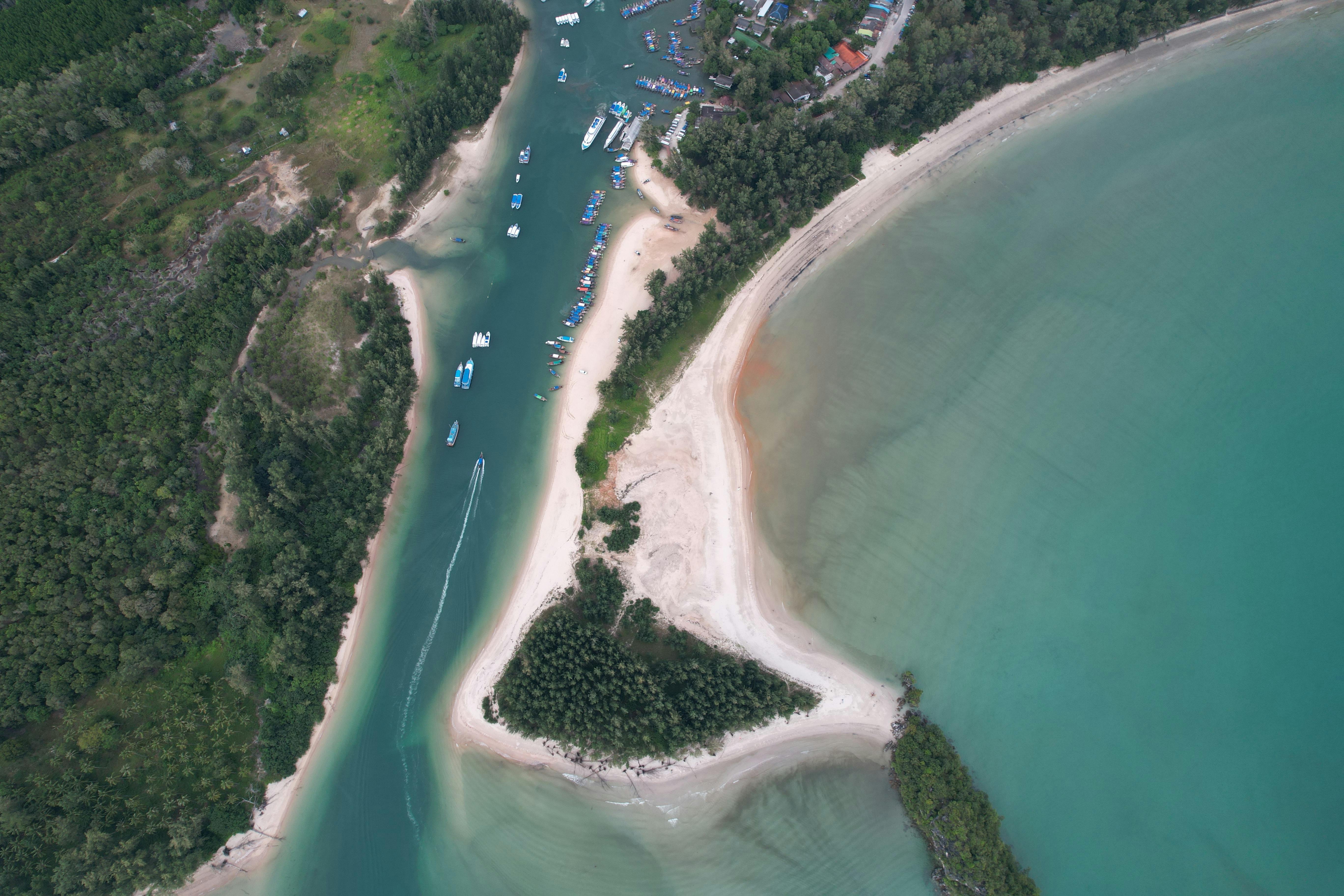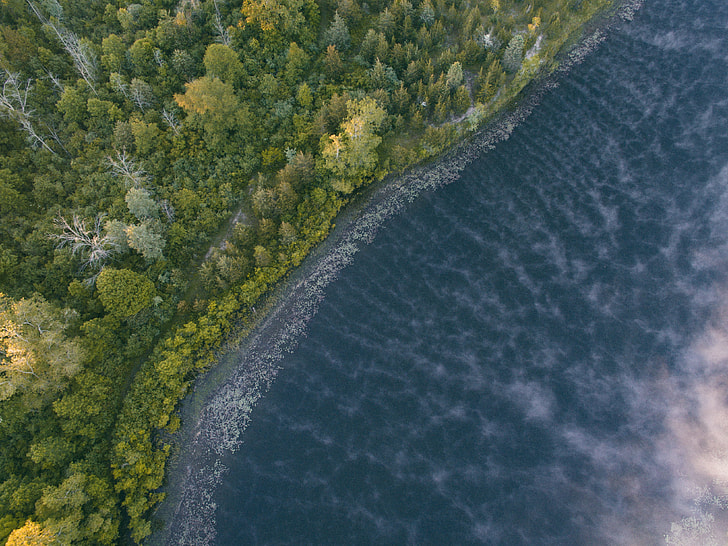Drone photography Mini eGuide
The Power and Potential of Drone Photography

“Drone Shot of Islands on a Sea · Free Stock Photo” from pexels.com and used with no modifications.
As we’ve seen in recent years, the emergence of drones have opened up new horizons in the realm of photography. So often, those scrolling their social media feeds stop dead at breathtaking landscapes and unmatched perspectives – the distinct signature of drone photography.
The Impacts of Drones on Modern Photography
Drones, or quadcopters as they’re technically named, have swooped into the world of visual aesthetics, presenting an exciting avenue for photographers. With their ability to reach seemingly impossible vantage points, drones have imparted a new dimension to the art form, capturing the grandeur and magnitude of our world in unique ways.
Think about it. The sky-high perspective once reserved for bird’s-eye views or expensive helicopter rides is now at our fingertips. This revolution has been quite a game-changer, indeed.
The Benefits of Aerial Perspective for Photographers
There are countless reasons why taking your camera to the sky can elevate the quality of your images – here are just a few:
- Unseen Patterns: An overhead perspective can reveal patterns, shapes, and textures in the landscape that aren’t visible from the ground. Their presence can transform a scenic vista into a piece of abstract art, intriguing viewers with these undiscovered details.
- Transformed Landscapes: From elevated angles, conventional surroundings can turn into exotic locales, making drone photography a versatile tool in a photographer’s repertoire.
- Cost-effective: Drones have removed the hefty price tag that was once associated with aerial photography. Renting aircraft or using expensive camera rigs are no longer the norm. It’s a great time to be a drone photographer with ambition and a creative mind!
Venturing into Drone Photography: Getting Started

“Royalty-Free photo: Aerial landscape photography of a beach near forest | PickPik” from pickpik.com and used with no modifications.
Exciting as it is, entering the world of drone photography requires careful consideration and preparation. Here are some steps to ensure you don’t stumble upon the common pitfalls.
Choosing the Right Drone for Your Needs
The first step, most importantly, is choosing the right drone that suits your needs and abilities. Remember, the most expensive drone isn’t necessarily the best for you.
For beginners, a basic, user-friendly drone is recommended. As skills develop, one can explore drones with advanced photo and video capabilities. In recent news, DJI has announced the Mini 4 Pro, a sub-250-gram drone with a bevy of sensors and smart flight features – worth checking out!
A Primer on Drone Features for Photography
A drone is more than just a flying camera. Each feature needs to be understood to exploit its capabilities fully:
- Camera: It’s imperative to choose a drone with an excellent camera quality. Some drones come with built-in cameras, while professional-grade drones may have the ability to mount DSLR cameras.
- Gimbal: This is a crucial feature for capturing steady footage. A 3-axis gimbal is generally considered ideal for ensuring steady shots, even in windy conditions.
- Battery Life: The battery life of drones varies considerably. Always carry extra batteries while shooting, and remember, drone’s battery life tends to decrease in colder weather.
- GPS: Drones with GPS are usually easier and safer to operate, offering features like automatic return-to-home functionality that can be a lifesaver for beginners.
[…]
Capturing Awe-inspiring Images: Drone Photography Techniques

“Long Exposure Drone Photo with Traffic Light Streaks on a … | Flickr” from flickr.com and used with no modifications.
The magic in the image isn’t just about the drone. It’s about you and how you set the scene, how you play with light, and how you frame the story.
Finding Your Own Perspective
Most importantly, in a world where anyone can fly a drone, your unique perspective will make your images stand out. By taking the time to explore various angles and heights and even studying other photographers’ work, you can visualize and plan your shots ahead of time. Google Earth is a great tool for this.
Playing with Light
Just like traditional photography, light plays a critical role in drone photography. The golden hours – just after sunrise and just before sunset – are known for their soft, warm hues and long shadows which can add depth and texture to your images.
Aside from these ideal times, experiment with different lighting situations. Drone flights during the harsh midday light or even nighttime can yield surprising and beautiful results!
Using the Rule of Thirds
Another vital drone photography technique is the Rule of Thirds. It’s a compositional rule in photography where the frame is divided into nine equal rectangles, three across and three down. The idea is to place the key elements of your scene along those lines, or at the points where they meet. But remember, it’s just a rule – and rules can be broken for creative purposes!
Experimenting with Scale and Patterns
Another drone photography tip is to experiment with scale. Adding a familiar object or person to the scene can give the viewer a sense of scale, creating a powerful contrast between the grand landscapes and the small details.
Shooting straight down is a popular drone technique that reveals patterns and formations in the landscape that are not visible from the ground. From high above, roads, trees and buildings can form interesting patterns that are hidden from the naked eye.
Post Processing: The Finishing Touches

“Drone Photography of an Island · Free Stock Photo” from pexels.com and used with no modifications.
Now, after capturing your jaw-dropping aerial shots, it’s time to enhance them through some post-processing.
Software like Photoshop or Lightroom can take your images to the next level, allowing you to adjust exposure, contrast, sharpness, and more. Besides finetuning your images, it’s also your opportunity to stamp your unique style on your work. Whether it’s punchy colors or monochrome, this is your chance to let your artistic voice be heard.
Drone Photography Add-Ons: A Photographer’s Best Friend
Your drone and camera aren’t the only tools in your arsenal. To ensure a smooth and successful flight, it’s also vital to consider the following items:
- Extra Batteries: Drone batteries have a limited lifespan. Carrying extras ensures you don’t missed that perfect shot because you ran out of juice.
- Propeller Guards: For beginners, propeller guards can prevent damage to your drone (and anything else) in case of collision.
- Extra Propellers: Sometimes accidents happen. Having spare propellers on hand means you won’t have to end your session early.
- SD Cards: Always have extra storage available. You never know when the perfect shot will come.
Drone photography has brought an exciting new spectrum to the world of photography, providing a new realm of possibilities for seasoned pros and newcomers alike. With these tips in mind, you’ll be on your way to capturing amazing drone photos. So get out there, start exploring, and most of all, enjoy the beauty of seeing the world from a whole new perspective. Happy flying!




